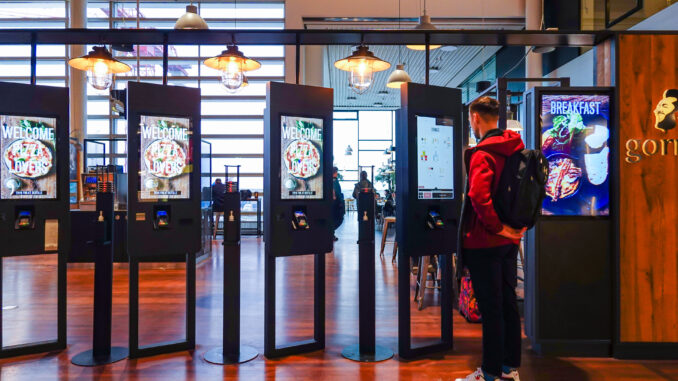
By Lea Mira, RTN staff writer - 4.11.2024
California’s recent decision to raise the minimum wage for fast food workers to $20 has reignited discussions about the role of technology in the restaurant industry. While some argue that higher labor costs will drive businesses to replace workers with technology, such as self-service kiosks, auto-refill technology and automated frying machines and other food preparation robotics, industry experts suggest that restaurant automation is already well underway, regardless of wage increases.
The recent legislation was defined through Assembly Bill 610. This bill established certain exemptions, excluding workers in nontraditional restaurant locations such as airports, hotels, event centers, theme parks, and corporate campus cafeterias from the wage increase. Initially, the bill also exempted restaurants that bake their own bread, such as Panera. However, following opposition, Governor Newsom clarified that Panera would indeed be subject to the new minimum wage law requirements. This clarification ensures that the wage increase is applied more uniformly across the restaurant industry, regardless of the specific services or products offered by individual establishments.
Higher wages could potentially benefit fast food owners by attracting workers in an industry that has yet to recover to pre-pandemic employment levels. The new wage law, which took effect on April 1, applies to restaurant chains with more than 60 nationwide locations. It also establishes a fast food council, a first in the US, which can increase the wage annually in line with inflation or up to 3.5%, whichever is higher. The council can also recommend standards for worker safety and collaborate with state agencies to investigate issues such as wage theft.
Self-service kiosks are becoming increasingly common in large fast food chains. Panera Bread, McDonald’s, and Shake Shack have all implemented self-service kiosks in recent years. Shake Shack executives have noted that customers tend to order more food when using a kiosk rather than interacting with a human cashier. Similarly, Burger King plans to roll out more digital self-service screens, citing larger orders and more prep time for kitchen staff as benefits.
While customer preference for autonomous ordering, particularly among younger consumers, is driving the adoption of self-service kiosks, the minimum wage increase could accelerate tech adoption in certain areas. Fast food franchisee Harsh Ghai, who owns 180 Burger King, Taco Bell, and Popeyes locations, is one such business owner who plans to install more self-service kiosks in response to the wage increase. Ghai told CNN in an interview that he is also looking to implement AI-powered drive-thru ordering and aims to remove registers completely from his restaurants. He argues that these changes are necessary to offset increased labor costs and maintain profitability.
The California Restaurant Association has noted that some restaurant operators are choosing not to expand or are closing locations due to the wage increase. Ghai himself has closed 14 restaurants in the past year. A recent report from the National Restaurant Association, which will be hosting its annual (and largely technology-focused) restaurant industry trade show in Chicago May 18-21, revealed that 16% of restaurants plan to integrate artificial intelligence into their businesses this year, while 25% plan to utilize self-ordering and payment kiosks. Nearly half of the restaurants surveyed said they plan to use tech and automation to address labor shortages.
The report also indicates a generational divide in attitudes towards technology in restaurants. While 64% of Gen Z and 66% of millennial adults believe that using technology creates a more positive dining experience, just 19% of baby boomers share this view. Some national chains, such as Wendy’s, are already implementing more AI into their business models, including automated speaker boxes at drive-thrus and dynamic pricing.
The adoption of technology in the restaurant industry is not limited to self-service kiosks and AI-powered ordering systems. Mobile pick-up restaurants, like the one recently debuted by Chick-Fil-A in New York City, are also gaining traction. These establishments have no seating and only prepare food for delivery or takeout, further streamlining the dining experience and reducing labor costs.
The integration of technology in the restaurant industry also extends to the back of the house. Automated frying machines and auto-refill technology are just a few examples of how restaurants are leveraging technology to increase efficiency and reduce labor needs. These innovations not only help to offset higher labor costs but also address the ongoing labor shortage in the industry.
However, the transition towards a more technologically driven industry is not without its challenges. While younger generations are more open to using technology in restaurants, older consumers may be less comfortable with these changes. As the industry continues to evolve, finding a balance that caters to all customers’ preferences will be crucial. This could potentially lead to a hybrid model, where traditional service coexists with self-service and automated options, providing a diverse dining experience that caters to a wide range of customer preferences.
While California’s wage increase may accelerate the adoption of automation and other technologies in many restaurants, it is clear that this trend was already well underway. The move towards a more technologically driven industry is not solely a response to higher labor costs, but also a reflection of changing consumer preferences, ongoing labor shortages and continuous technology innovation.

